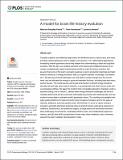Files in this item
A model for brain life history evolution
Item metadata
| dc.contributor.author | González Forero, Mauricio | |
| dc.contributor.author | Faulwasser, Timm | |
| dc.contributor.author | Lehmann, Laurent | |
| dc.date.accessioned | 2017-03-13T12:30:21Z | |
| dc.date.available | 2017-03-13T12:30:21Z | |
| dc.date.issued | 2017-03-09 | |
| dc.identifier | 249347430 | |
| dc.identifier | 6855ec8f-24b3-4aa8-9c80-e3164aa45bef | |
| dc.identifier | 85016820022 | |
| dc.identifier | 000398031900036 | |
| dc.identifier.citation | González Forero , M , Faulwasser , T & Lehmann , L 2017 , ' A model for brain life history evolution ' , PLoS Computational Biology , vol. 13 , no. 3 , e1005380 . https://doi.org/10.1371/journal.pcbi.1005380 | en |
| dc.identifier.issn | 1553-734X | |
| dc.identifier.other | ORCID: /0000-0003-1015-3089/work/60427699 | |
| dc.identifier.uri | https://hdl.handle.net/10023/10459 | |
| dc.description | This work was funded by Swiss NSF grant PP00P3-146340 to LL http://www.snf.ch/en/Pages/default.aspx. | en |
| dc.description.abstract | Complex cognition and relatively large brains are distributed across various taxa, and many primarily verbal hypotheses exist to explain such diversity. Yet, mathematical approaches formalizing verbal hypotheses would help deepen the understanding of brain and cognition evolution. With this aim, we combine elements of life history and metabolic theories to formulate a metabolically explicit mathematical model for brain life history evolution. We assume that some of the brain’s energetic expense is due to production (learning) and maintenance (memory) of energy-extraction skills (or cognitive abilities, knowledge, information, etc.). We also assume that individuals use such skills to extract energy from the environment, and can allocate this energy to grow and maintain the body, including brain and reproductive tissues. The model can be used to ask what fraction of growth energy should be allocated at each age, given natural selection, to growing brain and other tissues under various biological settings. We apply the model to find uninvadable allocation strategies under a baseline setting (“me vs nature”), namely when energy-extraction challenges are environmentally determined and are overcome individually but possibly with maternal help, and use modern-human data to estimate model’s parameter values. The resulting uninvadable strategies yield predictions for brain and body mass throughout ontogeny and for the ages at maturity, adulthood, and brain growth arrest. We find that: (1) a me-vs-nature setting is enough to generate adult brain and body mass of ancient human scale and a sequence of childhood, adolescence, and adulthood stages; (2) large brains are favored by intermediately challenging environments, moderately effective skills, and metabolically expensive memory; and (3) adult skill is proportional to brain mass when metabolic costs of memory saturate the brain metabolic rate allocated to skills. | |
| dc.format.extent | 28 | |
| dc.format.extent | 1645344 | |
| dc.language.iso | eng | |
| dc.relation.ispartof | PLoS Computational Biology | en |
| dc.subject | QH301 Biology | en |
| dc.subject | QA75 Electronic computers. Computer science | en |
| dc.subject | DAS | en |
| dc.subject.lcc | QH301 | en |
| dc.subject.lcc | QA75 | en |
| dc.title | A model for brain life history evolution | en |
| dc.type | Journal article | en |
| dc.contributor.institution | University of St Andrews. School of Biology | en |
| dc.contributor.institution | University of St Andrews. Centre for Biological Diversity | en |
| dc.identifier.doi | 10.1371/journal.pcbi.1005380 | |
| dc.description.status | Peer reviewed | en |
This item appears in the following Collection(s)
Items in the St Andrews Research Repository are protected by copyright, with all rights reserved, unless otherwise indicated.

